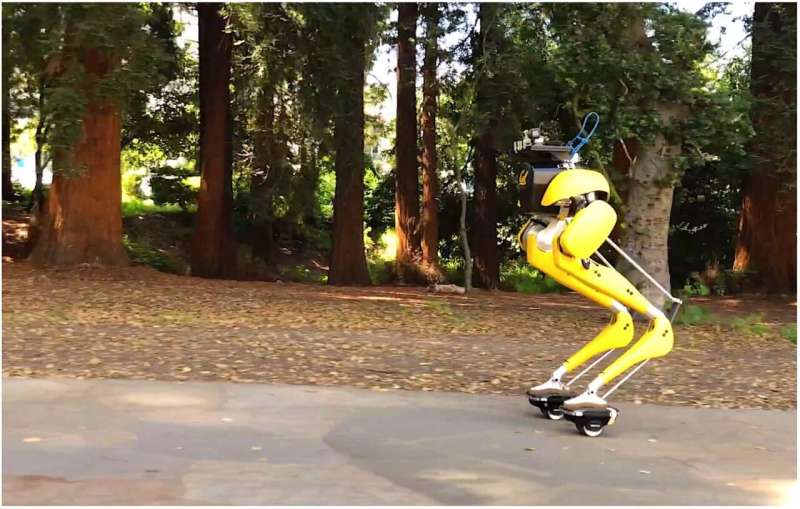June 11, 2019 weblog
Head-turning Cassie Cal makes campus moves on hovershoes

A bipedal robot called Cassie Cal is in the news, thanks to a video from its home at the Hybrid Robotics group at University of California Berkeley.
The video "Feedback Control for Autonomous Riding of Hovershoes by a Cassie Bipedal Robot" carries four wow features showing Cassie Cal riding in hovershoes (1) down a few stairs, (2) riding on uneven outdoor terrain, (3) up and down steep inclines, and (4) leaning into a turn to go around corners.
The bipedal robot Cassie is manufactured by Agility Robotics. InMotion makes the hovershoes.
Wait, what is that on its feet, hovershoes? For those who my not know what those are, let's do hovershoes before proceeding. Sounds like...hoverboards. Bingo. Hovershoes are two little hoverboards for the right and left feet.
InMotion call their hovershoes self-balancing skates; they said their invention "takes the concept of a hoverboard and splits it into two independent machines: one for each foot." They said the user experience feels more like rollerskating.
"Our feedback control and autonomous system allow for swift movement through urban environments to aid in everything from food delivery to security and surveillance to search and rescue missions," said the team in IEEE Spectrum. In play are a computer vision system, path planner and a feedback control strategy. They used the computer vision system for velocity estimation, and obstacle mapping.
Among the names in their video thank-you list at the end were those from University of Michigan's Cassie Blue team for their insight and expertise.
Last year, Matt Simon in Wired had an entertaining and informative article on Cassie as a research platform. Simon looked in on Jessy Grizzle's lab at the University of Michigan. They were submitting Cassie through a ringer with the intent to see it master bipedal locomotion under hardship circumstances such as rough terrain and steps.
One realizes that all the stupendous Atlas robots in the world cannot minimize the important of a robot like Cassie—back flips are great but Cassie might be a fitting solution for bipedals in crisis environments.
Simon: "Why bother with Cassie? Well, Atlas doesn't come without its downsides: Its hydraulic actuators are strong, yet necessarily bulky. Cassie, on the other hand, is a slimmer, electric design. So while Atlas might have the strength to, say, heft objects in a rescue situation, Cassie could more delicately move among humans in crowded cities. And it has the open research to start backing up lots of those kind of applications."
Fast-forward to Berkeley, California, 2019, where the Hybrid Robotics lab at UC Berkeley show their TLC for Cassie, with a new pair of self-balancing shoes and sensor package,—yes, it does computation onboard in realtime.
The shoes behave like two little hoverboards to zip it through all kinds of friendly and unfriendly terrain. IEEE Spectrum's Evan Ackerman got more specific on what the hovershoes do for Cassie.
"You balance on the skates, and control them by leaning forwards and backwards and left and right, which causes each skate to accelerate or decelerate in an attempt to keep itself upright. It's not easy to get these things to work, even for a human, but by adding a sensor package to Cassie the UC Berkeley researchers have managed to get it to zip around campus fully autonomously."
CNET: "Shuxiao Chen, Jonathan Rogers, and Bike Zhang, UC Berkeley students who worked on the project, said it took about eight months to teach Cassie to skate. The process involved mathematical models, simulations to test the algorithms and figuring out how to interface and communicate with Cassie and various sensors. In short: lots of trial and error."
Ackerman gave the lab a thumbs-up for their work on a controller. "It's a testament to the robustness of UC Berkeley's controller that they were willing to let the robot operate untethered and outside."
In the bigger picture, the labs' researchers are interested in bipedal robots being as efficient as possible over varied terrains, which might require locomotion modes beyond just walking.
IEEE Spectrum spoke to Berkeley students Shuxiao Chen, Jonathan Rogers, and Bike Zhang via email. "While locomotion using legs is efficient when traveling over rough and discrete terrain, wheeled locomotion is more efficient when traveling over flat continuous terrain. Enabling legged robots to ride on various micro-mobility platforms will offer multimodal locomotion capabilities, improving the efficiency of locomotion over various terrains."
© 2019 Science X Network



















